Pickleball, a sport known for its addictive nature and health benefits, has been growing in popularity.
With the increase in players, questions about the durability of the equipment arise, particularly regarding the paddles.
This article seeks to answer the crucial question: Do pickleball paddles wear out?
Join us as we explore the lifespan of paddles, factors that affect their durability, and tips to extend your paddle’s life on the court.
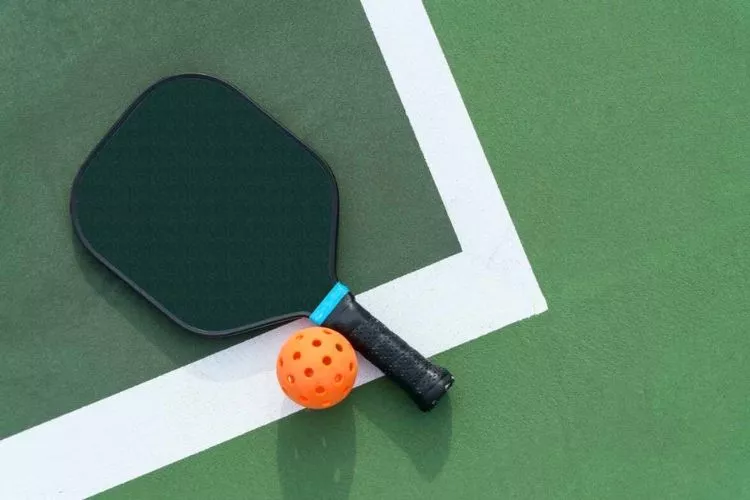
Do pickleball paddles wear out?
Yes, pickleball paddles do wear out over time. The lifespan of a paddle largely depends on the frequency and intensity of its use, the material it’s made from, and how well it’s maintained.
Common materials like wood, composite, and graphite each have unique wear patterns. For instance, wooden paddles tend to deteriorate faster than their composite or graphite counterparts.
Signs of wear include poor bounce performance, a noticeably lighter weight, chips or cracks, and loose grips. Paddle wear affects the game play, such as serving and striking accuracy.
It’s crucial for players to regularly examine their equipment for signs of wear and replace their paddles when necessary.
Paddle maintenance, including proper storage and cleaning, can also extend its lifespan. In general, with everyday use, a paddle can last between 1 to 5 years.
How long do carbon pickleball paddles last?
Carbon fiber or graphite pickleball paddles, known for their lightweight and durable quality, typically last longer than those made from other materials like wood or composite.
Despite their strength, they’re not immune to wear and tear. Generally, with moderate use, a carbon pickleball paddle can last between 3 to 5 years, and even longer with meticulous care and less frequent play.
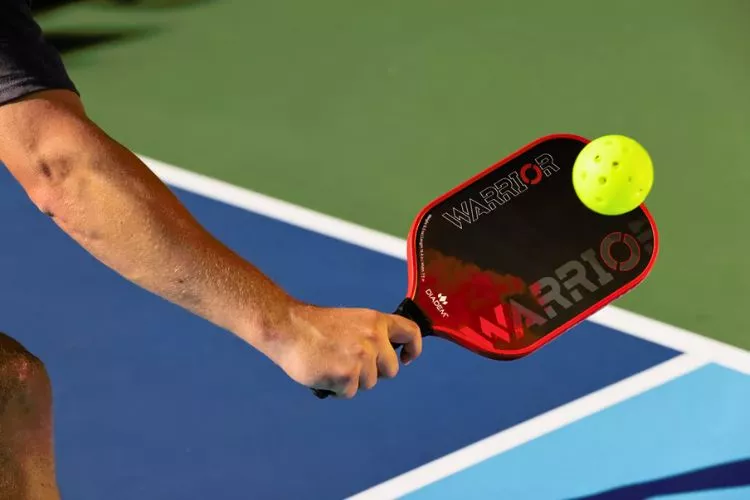
However, highly active or professional players may find their carbon paddles wearing out faster due to intense and consistent use.
Factors affecting the lifespan include frequency of play, gameplay intensity, storage conditions, and maintenance habits.
Check regularly for signs of wear such as poor bounce, surface roughness changes, cracks, or a reduction in weight.
Regular cleaning, careful handling, and proper storage can all help extend the lifespan of your carbon pickleball paddle.
How many games does a pickleball paddle last?
The exact number of games a pickleball paddle lasts varies depending on several factors. These include the material it’s made from, the frequency and intensity of play, and how well it’s maintained.
Generally, with moderate use, a high-quality paddle can last anywhere from 1 to 5 years.
However, professional players who frequently participate in intense games or practices might find their paddles wear out in less than a year.
How can you tell if a pickleball paddle is bad?
Several signs indicate a pickleball paddle may be past its prime, and it’s essential to evaluate both the paddle’s performance and physical appearance.
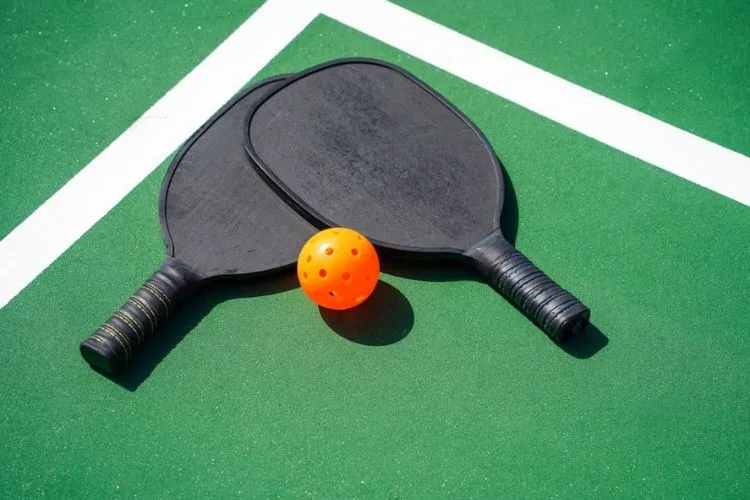
Performance Issues
- Loss of power: If you feel like your shots are lacking power or require extra force, the paddle’s core or face may have deteriorated.
- Inconsistent bounce: The ball should bounce consistently off the paddle. If there’s any irregularity in the way it responds, the paddle might be compromised.
- Vibration: If you notice vibrations when hitting the ball, it could be a sign of internal wear or damage that’s not externally visible.
- Less control: Difficulty controlling the direction and speed of the ball during play could indicate a paddle past its prime.
Physical Signs
- Chips or cracks: Significant damage to the paddle’s edge, face, or core can negatively impact its performance. Over time, subtler damage can get worse, causing even more noticeable issues.
- Loose grip: A worn or loose grip can result in less control over the paddle and can lead to discomfort or even injury. It may be possible to replace the grip itself, but if the paddle’s shaft is loose, it could also be time to replace the paddle.
- Fading surface: A worn-out honeycomb surface on the paddle can result in less bite during gameplay, which affects spin control. If the surface appears visibly smooth or deteriorated, it’s time to replace the paddle.
- Delamination: If the face of the paddle is peeling or separating from the core, it’s a clear sign that the paddle is no longer fit for play.
By evaluating these performance aspects and physical conditions, you can determine whether your pickleball paddle is bad or if it’s still suitable for use.
If you notice one or several of these issues, it’s time to consider a new paddle.
When should I upgrade my pickleball paddle?
Deciding when to upgrade a pickleball paddle is often a matter of personal judgement. However, typical indicators may include: poor performance during play, significant physical wear and tear, or a shift in your skill level.
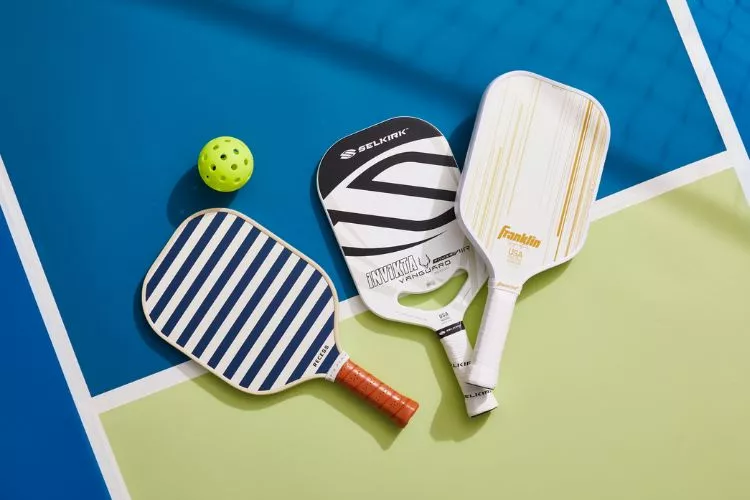
If you’re progressing in the game and getting more serious about it, upgrading your paddle to match your improving skills is a smart move.
Similarly, if your paddle is showing signs of heavy wear or isn’t performing as it used to, it might be time for an upgrade.
What can I do with old pickleball paddles?
Old pickleball paddles need not go to waste. They can be donated to local community centers, schools, or beginner players.
Alternatively, they can be upcycled into unique home or wall decorations, nameplates, or even clocks. For those interested in the technicalities, old paddles can be used to experiment with and understand various aspects of the sport better.
However, if a paddle is extremely worn out, it may be best to recycle it, if possible, according to the material guidelines in your area.
How do you evaluate pickleball paddles?
Selecting the right pickleball paddle can significantly impact your gameplay. Here are several factors to consider when evaluating pickleball paddles:
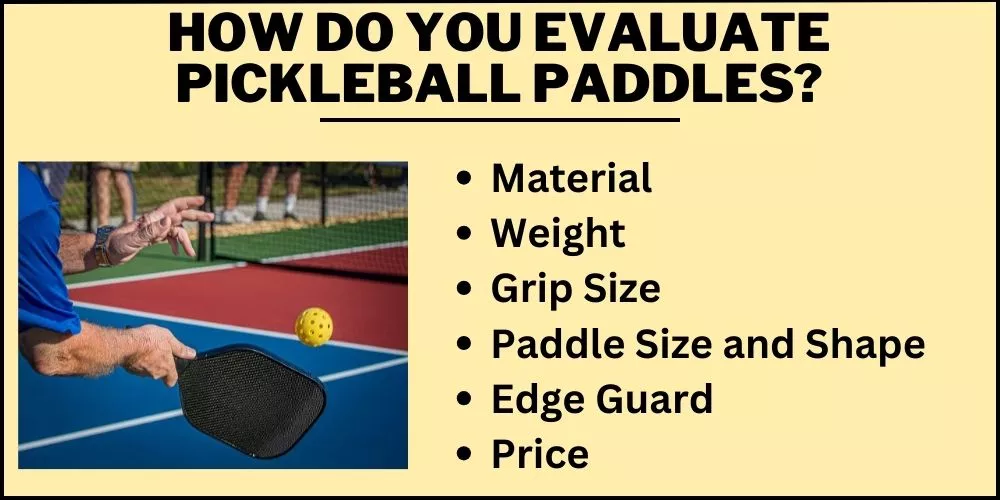
1. Material
Pickleball paddles come in a variety of materials, including wood, composite, and graphite (carbon fiber). Each material carries different characteristics:
- Wooden paddles are generally cheaper but significantly heavier. They’re good for beginners but may lack the power and precision found in other types.
- Composite paddles are a mix of different materials, offering a balance of power and control. They come in various weights and prices.
- Graphite paddles are lightweight and offer excellent touch, making them popular among advanced players. While costly, their performance on the court can justify the price for some players.
2. Weight
Weight significantly impacts the way you play:
- Lightweight paddles (<7.3 ounces) provide excellent maneuverability and quick responses at the net but may lack power.
- Middleweight paddles (7.3-8.4 ounces) strike a balance between power and control.
- Heavyweight paddles (>8.5 ounces) offer greater power for drives and smashes but might sacrifice a bit of control.
3. Grip Size
Similar to tennis rackets, the grip size of a paddle affects control and comfort during gameplay. To find the right grip size, use your height as a guide. Those under 5’2″ should consider a 4″ grip, between 5’3″ and 5’8″ a 4 1/4″ grip, and over 5’9″ a 4 1/2″ grip. It’s crucial to try different grip sizes before making your final decision.
4. Paddle Size and Shape
The size and shape of your paddle influence the way you play:
- Widebody paddles offer a larger hitting area, which could be beneficial for beginners.
- Oversized or elongated paddles provide more reach and power, but the smaller width may lessen the sweet spot.
5. Edge Guard
A thick edge guard protects the paddle from damage but can lead to mis-hits because it reduces the hitting area. Some paddles come without an edge guard, providing a larger sweet spot.
6. Price
The price reflects the paddle’s materials and construction quality. While more expensive paddles usually offer better performance, consider your commitment level to the game before making a significant investment.
In essence, understanding your playing style, abilities, and preferences can guide you towards the best pickleball paddle for your needs.
Conclusion:
Pickleball paddles do wear out over time, with their lifespan influenced by various factors such as material, frequency and intensity of play, and proper care.
While high-quality paddles can last for years, even the best paddles are not immune to wear and tear.
Regularly checking for signs of wear such as diminished ball bounce, surface degradation, or cracks is essential.
Whether you’re a casual player or a hardcore enthusiast, maintaining your equipment is key, but remember—when your paddle starts hinting it’s past its prime, don’t hesitate to replace it to maintain optimal performance on the court.

Pickleball’s more than a game to me—it’s a passion. I write, sharing its highs and lows, the thrills and the lessons. Some tales might draw you to the court, while others give a hint of the game’s magic. So, curious about my journey? Ready to dive deep into the world of pickleball with me? Let’s go.
